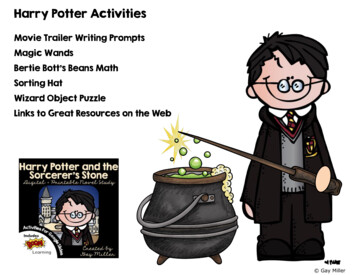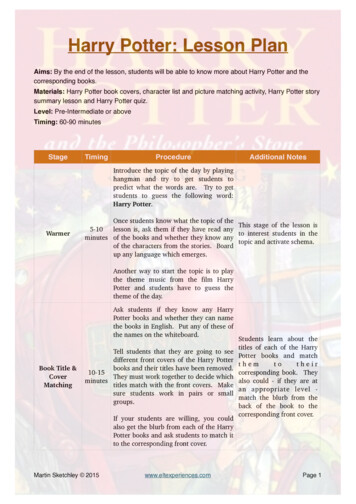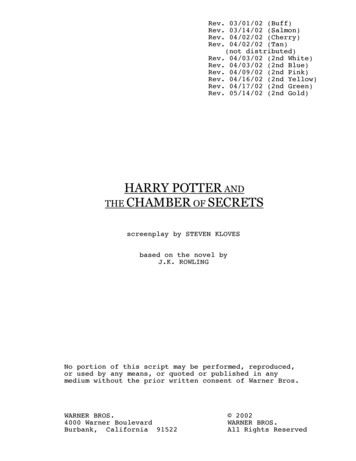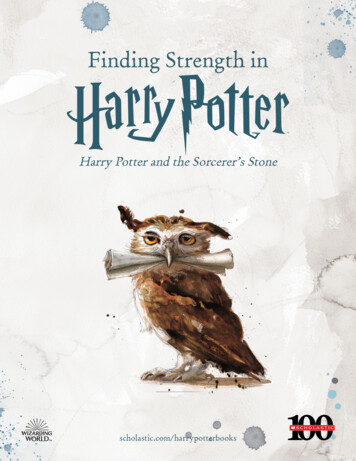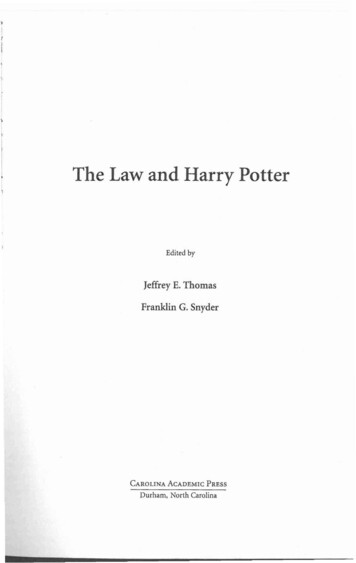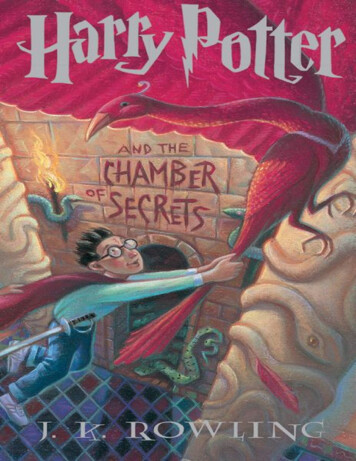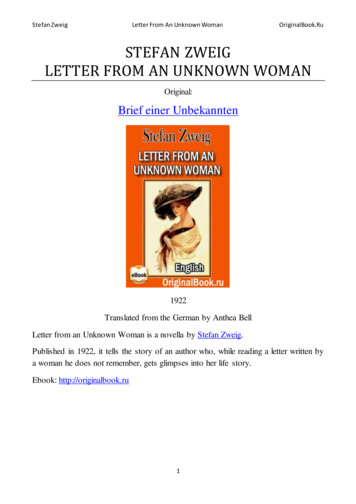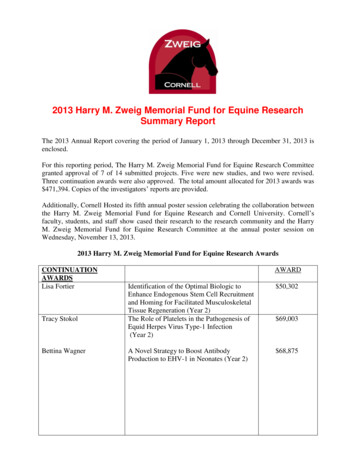
Transcription
2013 Harry M. Zweig Memorial Fund for Equine ResearchSummary ReportThe 2013 Annual Report covering the period of January 1, 2013 through December 31, 2013 isenclosed.For this reporting period, The Harry M. Zweig Memorial Fund for Equine Research Committeegranted approval of 7 of 14 submitted projects. Five were new studies, and two were revised.Three continuation awards were also approved. The total amount allocated for 2013 awards was 471,394. Copies of the investigators’ reports are provided.Additionally, Cornell Hosted its fifth annual poster session celebrating the collaboration betweenthe Harry M. Zweig Memorial Fund for Equine Research and Cornell University. Cornell’sfaculty, students, and staff show cased their research to the research community and the HarryM. Zweig Memorial Fund for Equine Research Committee at the annual poster session onWednesday, November 13, 2013.2013 Harry M. Zweig Memorial Fund for Equine Research AwardsCONTINUATIONAWARDSLisa FortierTracy StokolBettina WagnerAWARDIdentification of the Optimal Biologic toEnhance Endogenous Stem Cell Recruitmentand Homing for Facilitated MusculoskeletalTissue Regeneration (Year 2)The Role of Platelets in the Pathogenesis ofEquid Herpes Virus Type-1 Infection(Year 2) 50,302A Novel Strategy to Boost AntibodyProduction to EHV-1 in Neonates (Year 2) 68,875 69,003
NEW AWARDSDorothy AinsworthFine Mapping of Candidate GenesContributing to equine Left RecurrentLaryngeal Neuroptathy (RLN) (1 yearaward) 45,828Douglas AntczakT-Cell Mediated Immunity and VaccineDevelopment in Horses(2 Year award)Cellular Biomarkers of Early Cartilage injuryMeasured with Multiphoton Imaging1 year award)Etiology and Prevention of Equine SerumHepatitis (Theiler’s Disease) (2 year award)An exploratory Study into the Practicalapplication of a Regenerative MedicineApproach to Reconstruction of the EquineUpper Airway (1 year award)Osteoarthritis Control through CombinatorialStem Cell Therapy (1 year award)Innate Immune Mechanisms and T-CellResponses to Equine Herpesvirus Type 1 inLatently Infected and Naïve Horses(2 year award) 50,000Lisa FortierThomas DiversNorman DucharmeAlan NixonBettina Wagner 46,412 67,000 96,977 80,147 85,030Interim & Completed 2012 AwardsDr. Lisa Fortier’s project entitled “Identification of the Optimal Biologic to EnhanceEndogenous Stem Cell Recruitment and Homing for Facilitated Musculoskeletal TissueRegeneration.” Dr. Fortier received a no cost extension through June 30, 2014. A progressreport is included herein.Dr. Linda Mittel’s project entitled “Detection of Spirochetes, Rickettsia, and other Bacteriaand Parasitic Protozoa (often vector born) that Cause Fevers of Unknown Origin in Horsesand in Horse-Associated Ticks in the Northeast, Mid-Atlantic, and Great Lakes Regions”received a no cost extension through June 30, 2014. A final reoprt will be included nextyear.Dr. Tracy Stokol’s project entitled “The Role of Platelets in the Pathogenesis of EquidHerpes Virus Type-1 Infection.” Dr. Stokol received an additional no cost extension throughJune 30, 2014. A progress report is included herein.
FURTHER SECURED FUNDING FROM ZWEIG AWARDS IN 2013The Incentive Program enables the Fund to leverage its investment in Zweig-sponsored researchby encouraging Veterinary College faculty to seek either additional or supplementary moniesfrom external sponsors that base their award decisions on a process that involves informedscientific review. The external grant must be closely related to a Zweig project. Eligiblesponsors include, but are not limited to, the Grayson Foundation, the NIH, the NSF, and theUSDA’s National Research Initiative. Recipients provide an annual report on the use of thesefunds.The following external grant awards resulted from Zweig funding:PrincipalInvestigatorDr. Lisa FortierKira NovakofskiDr. Doug AntczakSamantha BrooksExternal AwardCellular Biomarkers ofEarly Cartilage injuryMeasured withMultiphoton 31/14Genetic Studies ofEquine Sarcoid TumorsMorris AnimalFoundation01/01/13 12/31/14AwardedAmount 54,457IncentiveAward 2,723 46,296 4,629PUBLICATIONSPublications resulting from awards from the Harry M. Zweig Memorial Fund for EquineResearch during 2013 were:Increasing Platelet Concentrations in Leukocyte-Reduced Platelet-Rich PlasmaBoswell, SG, Schnabel LV, Mohammed, HO, Sundman EA, Minas T, Fortier LA.http://www.ncbi.nlm.nih.gov/pubmed/24136860 (in press)The anti-inflammatory and Inflammatory and matrix Restorative Mechanisms ofPlatelet-Rich Plasma in OsteoarthritisSundman EA, Cole BJ, Karas V, Della Valle CJ, Tetreault MW, Fortier LA.J Bone Joint Surg 2012; (in press)http://www.ncbi.nlm.nih.gov/pubmed/24192391 (in press)Preovulatory Progestagen Treatment in Mares Fails to Delay OvulationCanisso IF, Gallacher K, Gilbert MA, Korn A, Schweizer CM, Bedford-Guaus SJ, GilbertRO http://www.ncbi.nlm.nih.gov/pubmed/23384437 (2013)
Effects of Clopidogrel on Horses with Experimentally Induced EndotoxemiaWatts AE, Ness SL, Divers TJ, Fubini SL, Frye AH, Stokol T, Cummings KJ, Brooks MB.http://www.ncbi.nlm.nih.gov/pubmed/25061708 Am J Vet Res. 2014 Aug;75(8):760-9Antibodies to OspC, OspF and C6 antigens as Indicators for Infection with Borrelia Burgdorferiin Horses. Wagner B, Goodman LB, Rollins A, Freer HShttp://www.ncbi.nlm.nih.gov/pubmed/23432019 (in press)Genomic Analysis Establishes Correlation between Growth and Laryngeal Ceuropathy inThoroughbredsBoyko AR, Brooks SA, Behan AL, Castelhano M, Corey E, Oliveira KC, Todhunter RJ,Zhang Z, Ainsworth DM, Robinson NE )Identification of Cartilage Injury using Quantative Multiphoton MicroscopyNovakofski KD, Williams RM, Fortier, LA, Mohammed HO, Zipfel WR, Bonassar /S1063458413009813 ) (2013)Identification of the Optimal Biologic to Enhance Endogenous Stem Cell RecruitmentHomes H, Wilson B, Silverberg J, Goerger J, Fortier /abs1196.html (2013)Development of an Equine Model of Talocrural Post-Traumatic OsteoarthritisDelco M, Bonassar L, kennedy K, Tuan R, alexander P, Foriter /abs346.html (2013)Response of Cartilage Impact Between Multiple Joints and Implications for the Development ofPostTtraumatic OsteoarthritisNovakofski K, Berg L, Bronzini L, Fortier L cyte Death Quantified using FDA-Approved Fluorescein is Increased Near MatrixCracks Resulting from Traumatic InjuryNovakofski K, Williams R, Bonassar L, Fortier /abs1319.html (2013)Genomic Analysis Establishes Correlation between Growth and Laryngeal Neuropathy inThoroughbredsBoyko AR, Brooks SA, Behan AL, Castelhano M, Corey E, Oliveira KC, Todhunter RJ,Zhang Z, Ainsworth DM, Robinson 64-15-259.pdf (2013)
GWAS identification of loci for susceptibility to recurrent laryngealneuropathy in theThoroughbred horse. International Plant and Animal Genome Meeting, January 12,2013, San Diego, CA. (oral abstract).Brooks SA, Boyko A, Robinson NE, Ainsworth DM, Todhunter RJ, Zhang Z, Behan A,Corey E 7.htmlGenetic Studies of Recurrent Laryngeal Hemiplegia in the Thoroughbred Horse. InternationalEquine Genome Workshop (10th Dorothy Russell Havemeyer Foundation), July 10-13, 2013,Azores, Portugal (poster). Brooks SA, Boyko A, Robinson NE, Ainsworth DM, TodhunterRJ, Zhang Z, Behan A, Corey EGenetics of Recurrent Laryngeal NeuropathyBrooks SAThe 5th World Equine Airways Symposium, July 16, 2013, Calgary, Canada %20Rahil.pdfEffects of Hypoglossal Nerve Block and Electrical Stimulation of the Thyrohyoideus Muscleson Position of the Larynx and Hyoid Apparatus in Healthy Horses.Zantingh AJ, Ducharme NG, Mitchell LM, Cheetham s of Clopidogrel on the Platelet Activation Response in HorsesBrooks MB, Divers TJ, Watts AE, Ness SL, Frye AH, Stokol T, Fubini SLhttp://www.ncbi.nlm.nih.gov/pubmed/23977894 (2013)Jonathan Cheetham, VetMB, PhD, DipACVSZweig Principal Research Scientist 2012-2013At the November 15, 2012 Annual meeting, Dr. Jonathan Cheetham was appointed as the firstZweig Research Scientist 2012-2013. His appointment is for the period January 1, 2013through December 1, 2013, with a possible renewal to be approved at the next annual meetingof the Zweig Committee. Acknowledgement of this prestigious award is included herein.
Jonathan Cheetham, VetMB, PhD, DipACVS2012 Harry M. Zweig Memorial Fund for Equine ResearchPrincipal ResearchScientist AwardDr. Cheetham is honored to have been named the first Harry M. Zweig Memorial Fund forEquine Research Principal Research Scientist, noting that the award is an exceptionalrecognition and honor for an early career investigator. He appreciates the award, and honoredthat the Zweig Committee and College recognized his efforts as a clinician scientist andprovided the award to foster his research. The award has had a tremendous impact on thecontributions made on behalf of the Harry M. Zweig Memorial Fund for Equine Research atthe College of Veterinary Medicine at Cornell University, and has allowed him to pursue andfocus on a line of investigation and development that will lead to regenerative therapies forequine laryngeal disease. The research is progressing well, and the ongoing, long-term projectwill produce a fundamental shift in the way in which horses are treated for Recurrent LaryngealNeuropathy (RLN), or “Roaring” which is a significant performance limiting problem in bothracehorses and sports horses.Career Development ActivitiesDuring the past fiscal year, he also received a promotion from Research Scientist to PrincipalResearch Scientist. Additionally, h i s l aboratory was successful in obtaining a three-yearNIH “Small Grant Award” and he was honored as the recipient of the 2013 Zoetis ResearchExcellence Award in Animal Health. Career development activities have included, attending aYoung Investigators grant writing workshop held by the United States Bone and JointInitiative and serving as co-chair of the Department of Clinical Sciences Research Committee.This ongoing work will have widespread application and would not have been possiblewithout support from the Harry M. Zweig Fund for Equine Research. He is grateful for thesupport and the protected time to pursue research to advance the field, and this prestigiousaward has made a profound impact on his career.
CORNELL CLINICAL FELLOW IN EQUINE HEALTHAt the 2007 Annual meeting, the Harry M. Zweig Committee approved the allocation of funds tohelp support a Cornell Clinical Fellow in Equine Health. Dr. Sophy Jesty was selected asCornell’s first Clinical Fellow, followed by Dr. Sarah Pownder, and more recently anotherindividual has been identified as a Clinical Fellow, and supported in part by Zweig funds, andall have been highly successful. Cornell’s College of Veterinary Medicine’s two-year ClinicalFellows Program is the first in the country to address a growing shortage of academicveterinarians who conduct research on animal diseases and basic biology. The program isdesigned to help students meet the financial and time demands of qualifying for a position inveterinary academic medicine, which has traditionally required students to complete an M.S. orPh.D. after they finish their doctorate in veterinary medicine (DVM). The two-year program,available to veterinarians who have completed a three-year residency, offers an annual salary of 65,000 plus benefits and an additional 15,000 per year to fund a research project.OUTREACH 2013Patent updates for 2013During 2012, Dr. Chang applied for patent 3080-10 “Novel Immunologenic Proteins ofLeptospira” patent application number 13/459,791In 2013 patent D-3080-07 – “Immunogenic Proteins of Leptospira” US patent 8,168,207, wasissued to Dr. Chang on May 1, 2013.Provisional patent application No. 61/903,619 (US); submitted 11/13/2013; “Stimulation ofNeonatal Immunity”. Inventors: B. Wagner, G. Perkins; Applicant: College of VeterinaryMedicine, Cornell University, Ithaca, NY (2013).Zweig News CapsulesThere were two issues of the Zweig News Capsule published in 2013. Copies of these issues canbe found in Appendix (E).All Zweig News Capsules can be found at the Zweig Website at: and the latest one is attached:http://www.vet.cornell.edu/zweig/SUMMARY OF EXPENDITURESThe 2013 Summary of Allocations was presented and approved at the Zweig Committee AnnualMeeting in November 2012 (Appendix B).2014 ZWEIG PROGRAMSix projects were approved for funding, from a roster of 12 applications, at the Harry M. ZweigMemorial Fund annual November 2013 meeting. The list of projects funded for 2014 are shownin (Appendix D).
APPENDIX AProgress & Final Reports Resulting from 2013 FundingDr. AinsworthFine Mapping of Candidate Genes contributing to EquineLeft Recurrent Laryngeal Neuropathy (RLN)Dr. AntczakT-Cell Mediated Immunity and Vaccine Development inHorsesDr. DiversEtiology and Prevention of Equine Serum Hepatitis(Theiler’s Disease)Dr. DucharmeAn Exploratory Study into the Practical Application ofRegenerative Medicine Approach to Reconstruction of theEquine Upper Airway”Dr. FortierCellular Biomarkers of Early Cartilage Injury Measured withMultiphoton ImagingDr. FortierIdentification of the Optimal Biologic to EnhanceEndogenous Stem Cell Recruitment and Homing forFacilitated Musculoskeletal Tissue RegenerationDr. NixonOsteoarthritis Control through Combinatorial Stem CellTherapyDr. StokolThe Role of Platelets in the Pathogenesis of Equid HerpesVirus Type-1 InfectionDr. WagnerA Novel Strategy to Boost Antibody Production to EHV-1 inNeonatesDr. WagnerInnate Immune Mechanisms and T-Cell Responses toEquine Herpesvirus Type 1 in Latently Infected and NaïveHorses
Harry M. Zweig Memorial Fundfor Equine Research2013 Progress reportP.I.:Dr. Dorothy AinsworthTitle:Fine Mapping of Candidate Genes Contributing to Equine LeftRecurrent Laryngeal Nuropathy (RLN)Project Period:1/1/11-12/31/13Reporting Period:1/1/13-6/30/13Dr. Ainsworth was granted a no cost extension through June 30, 2014. A Progress report isattached.
2013 HARRY M. ZWEIG MEMORIAL FUNDFOR EQUINE RESEARCH PROGRAM PROGRESS REPORTPROJECT TITLE: Fine Mapping of Candidate Genes Contributing to Equine Left RecurrentLaryngeal Nuropathy (RLN)PRINCIPAL INVESTIGATOR(S): DM Ainsworth, NE Robinson, J Swinburne, RJTodhunter, Z Zhang, J Stick, NG Ducharme.A. GWAS of 550 Thoroughbred horses establishes a correlation between withers heightand RLN. In horses affected with RLN, the distal axon of the recurrent laryngeal nerve, thelongest nerve in the horse’s body, degenerates causing secondary paresis to complete paralysis ofthe intrinsic laryngeal muscles. Neurogenic atrophy of one particular laryngeal abductor, the leftcricoarytenoideus dorsalis (CAD), prevents maximal abduction of the left arytenoid cartilage.This results in laryngeal airflow obstruction, poor pulmonary gas exchange and reduced athleticperformance. The prevalence of RLN ranges from 2-11% in Thoroughbreds and 35-46% inDraft horse breeds (Lane et al., 1987; Brakenhoff et al., 2006). The presence of genetic factorscontributing to RLN is suggested by the observation that offspring of RLN-affected stallions aremore likely to be affected with the disorder than are offspring from unaffected stallions(Ohnesorge et al., 1993). However, prior to our team undertaking this study in 2011, thegenetics of RLN had not been extensively investigated in Thoroughbreds.Using a cohort of 550 well-phenotyped Thoroughbred horses, we conducted a GWAS using thenewer Illumina Equine SNP70 Beadchip (65, 157 markers). We first performed a GWAS onwithers height using sex and gelding as covariates (heights were recorded for 505Thoroughbreds) and found strong signal association on ECA3 (104.4-109.0 Mb). The strongestassociation signal (P 1.3 x 10-22) was centered on SNP BIEC2 808543 (Figure 3A) adjacent tothe ligand dependent nuclear receptor corepressor-like (LCORL) and non-SMC condensing Icomplex subunit G (NCAPG) genes. Our results confirmed independent studies documenting astrong association between the LCORL/NCAPG region and body size in the horse (MarvandiNejad et al, 2012; Tetens et al, 2013). In our study we found that although height differedsignificantly between mares, geldings and stallions, gender and gelding only explained 7% of thevariation in height in the samples. In contrast the LCORL/NCAPG minor (G) allele count atBIEC2 808543 had an effect of increasing height 3.7 cm (SE 0.4) and explained 16.7% of thevariation in height in the data set. This effect was roughly additive and consistent in sires, maresand geldings (Table 1, below right).Table 1. Frequency of marker BIEC2 808543 with height .5169.8Total162.3166.2169.7Risk of 88Total0.430.650.90Average Height (cm)StallionGeldingMareFigure 3: The Manhattan Plots (sex andgelding as covariates). Table 1: Possessing
Possessing the G allele at the BIEC2 808543SNP demonstrate the association of height with ECA(Panel A) and of is associated with a greater height and risk of having RLN. RLN with ECA3(Panel B). [From Boyko et al., 2013] [From Boyko et al., 2013]A GWAS for RLN (sex and gelding as covariates) demonstrated the strongest association withRLN (Panel B Figure 3) near the same LCORL/NCAPG locus (ECA3 105.1-105.5 Mb).Including height as an additional covariate in the model yielded no more significant associationsalthough regions of ECA23 (36.2-39.8Mb) and ECA18 (65.8-67.0 Mb) showed suggestiveassociations with RLN (P 5.6 x 10-6 and 1.6 x 10-5, respectively; See Boyko manuscript inAppendix for these Manhattan plots). GWAS for RLN without covariates also yielded anadditional suggestive association on chr X at 57.8 Mb as shown in Figure 1, page 2). Thus 4QTLs were associated with RLN, the strongest signal being on ECA3.Next, linkage disequilibrium among the SNPs was investigated for the height and RLN locus onECA3. A haplotype (i.e. a set of SNPs on a single chromosome that are associated statistically)for height consisted of an eight SNP block spanning ECA3 (105.3-105.8 Mb, P 8.18 x 10-23), agenomic region that included the LCORL/NCAPG genes (Figure 4, below). A haplotypegenerating the smallest P-value for RLN (P 6.29 x 10-11) consisted of a seven SNP block(105.8-105.9 Mb) which overlapped with the height haplotype block by two markers and alsoincluded the 5’ half of the FAM184B gene.Figure 4: Shown are the statistical andspatial relationships between SNPs(vertically labeled by name) in thecandidate region for height and RLN. Thehaplotype block for height is highlightedin black (triangle) and that for RLN is inshown in gold. Haplotype location relativeto ECA3 genes is also shown.B. A custom-designed, high density SNPpanel improves resolution of ECA3 locus(Focus of 2013 Zweig). In an effort toseparate RLN SNPs from their close association with the height SNPs, we designed a highdensity SNP panel consisting of 150 new and 53 previously tested SNPs. The new panelimproved coverage of ECA3 (115 SNPs) as well as that of ECA18 (25 SNPs) and chr X (27SNPs). We also included SNPs on ECA6 (31 SNPs), ECA9 (3 SNPs) and ECA 11 (2 SNPs)because these chromosomes contain genes associated with equine growth and size (HMGA2;ZFAT, LASP1). The Thoroughbred DNA set was again genotyped, the data were re-analyzed andnew Manhattan Plots were generated. Shown in Figure 5 is the new GWAS for RLN (with sexand gelding as covariates). Green dots represent SNP P-values from the custom-designed panel;black and gray dots are those from the EqSNP70 chip. Note that additional SNP P-valuesexceeded Bonferroni significance showing that we had indeed improved our coverage of ECA3.No SNPs on ECA18 or chromosome X exceeded threshold for significance. (See Figure 2, page3 for RLN Manhattan Plot without covariates). The new haplotype analysis is shown in Figure6, below. Note that the RLN haplotype block has moved further to the right of the heighthaplotype block but the two blocks remain associated, reflecting the long LD of the
Thoroughbreds. Thus, to further interrogate these regions, we propose to conduct an across-breedapproach by studying RLN in Belgian Draft Horses. These horses are ideal because they havemuch shorter linkage disequilibrium and a higher prevalence of RLN compared to theThoroughbred. At the end of our studies we hope to dissociate the RLN locus from the heightregion, or conclusively prove that they are one in the same, and identify candidate genesresponsible for RLN.Figure 5:RLN GWAS – ECA3 signalFigure 6: Revisedhaplotype plot based upon data from customdesigned SNP panel is enhanced. (Custom) andEqSNP70 (GWAS). RLN locus (gold) is locatedfurther to the right of, but remains associated withthe height locus due to the long LD inThoroughbreds.
Harry M. Zweig Memorial Fundfor Equine Research2013 Annual ReportP.I.:Dr. Douglas AntczakTitle:T-Cell Mediated Immunity and Vaccine Development in HorsesProject Period:Reporting Period:1/1/13-12/31/141/1/13-12/31/13
2013 HARRY M. ZWEIG MEMORIAL FUNDFOR EQUINE RESEARCH PROGRAM ANNUAL REPORTPROJECT TITLE: T-cell Mediated Immunity and Vaccine Development in HorsesPRINCIPAL INVESTIGATOR(S): Douglas F. Antczak, Rebecca Tallmadge, NikolausOsterriederOriginal Specific Aims: These aims have not been modified.1) To identify the most important MHC class I molecule that presents immunogenic peptide afterEHV-1 infection in a common and well-studied horse MHC type;2) To determine the amino acid sequence of the EHV-1 peptide bound by that MHC class Imolecule;3) To use the identified EHV-1 peptide sequence to predict peptides from other horse pathogensthat bind to this MHC class I molecule.We have made good progress in the first nine months of this award.Principal results have been in 3 areas:1) Continued development of P-815 and RMA-S cell lines transfected with individualequine MHC class I genes.We have now produced a total of 17 P-815 transfectants expressing MHC class I molecules.These include all 7 of the well-characterized MHC class I genes of the ELA-A3 haplotype, andputative peptide presenting MHC class I molecules of the ELA-A1, -A2, -A5, -A9, and -A10haplotypes. These cell lines are now available for testing in cytotoxic lymphocyte (CTL) assays.We have also produced 7 MHC class I gene transfectants in the RMA-S cell line that we areusing in MHC stabilization assays using defined peptides (see section 2 below). The transfectedequine MHC class I genes in RMA-S are 7-6 (ELA-A1 haplotype), 16*00101 (ELA-A2),N*00101 (ELA-A2), 5*00101 (ELA-A3 and other haplotypes, a non-classical MHC class Igene), 1*00101 (ELA-A3), 4*00101 (ELA-A3), and 1*00201 (ELA-A9). The horse MHC class Igenes in these transfectants behave exactly like the endogenous mouse class I genes: themolecules are not expressed at 37 degrees but they do express when held overnight at roomtemperature.2) Application of the RMA-S cell line peptide-MHC stabilization assay.We have had success in stabilizing horse MHC class I genes in RMA-S cells using two peptidesand genes from two MHC haplotypes. First, as proof of principle we used the Equine InfectiousAnemia Virus (EIAV) peptide previously identified at Washington State University to stabilizeexpression of the 7-6 gene (RVEDVTNTAEYW). We were able to stabilize equine MHC class Iexpression in the RMA-S transfectants by adding this peptide to the cultures (Fig. 1). We tested10 overlapping peptides surrounding the original 12-merand defined critical amino acids at the left and right endthat were essential for peptide binding and stabilization(data not shown). Irrelevant control peptides did notstabilize the 7-6 gene, and the 7-6 peptide did notstabilize the endogenous mouse MHC class I gene orother horse MHC class I genes in other RMA-Stransfectants (data not shown).
Figure 1. Peptide stabilization of equine MHC class I genes transfected in mouse RMA-Scells. Cells: RMA-S cells transfected with the 7-6 MHC class I gene. Stabilization by the EIAVpeptide RVEDVTNTAEYW. Green profile: immunofluorescence using directly labeled mouseanti-horse MHC class I monoclonal antibody CZ3. Red profile: negative control.The EIAV peptide study was performed at Cornell. In parallel and using the same assay,research in Dr. Klaus Osterrieder’s lab in Berlin identified a peptide from human adenovirus thatstabilized expression of the 16*00101 MHC class I gene of the ELA-A2 haplotype. This wasdone using a small peptide library and is the first identification of an unknown equine MHCbinding peptide using the RMA-S stabilization assay.3) Establishment of collaboration with the MHC peptide group at the La Jolla Institute ofAllergy and Immunology.The research group at the La Jolla Institute of Allergy and Immunology (LIAI) led by Dr. AlexSette are world leaders in identifying MHC binding peptides using various binding assays andbioinformatics. They also work closely with Dr. Don Hunt’s group at the University of Virginiato identify peptide binding motifs using tandem mass spectrometry on peptides eluted fromindividual MHC molecules isolated from cells using antibody affinity columns. In January of2013 Drs. Antczak and Tallmadge and Don Miller met with Dr. Sette and his colleagues at LIAIto discuss possible collaborations. We have begun to work together, exchanging data, protocols,and reagents, including new peptides for testing.We have developed a unique collection of mouse cell lines transfected with individual horseMHC class I genes. We have also demonstrated how the RMA-S MHC-peptide stabilizationassay can be used to identify peptides that bind horse MHC class I molecules. This approachwill facilitate identification of immunogenic peptides that bind to equine MHC class I moleculesfor presentation to the T-cell receptor. This is a critical step in the design of new vaccines thatstimulate cell-mediated immunity.Our overall goals remain the same for Year 2. However, our emphasis has changed because ofexperimental successes and events of the past 9 months.First, we plan to focus on using the transfected RMA-S cell lines to identify peptides thatstabilize equine MHC class I molecules. This will require peptide libraries. We have receivedsome peptides from the LIAI group that we have begun to test and we have ordered a peptidelibrary that will be used with the RMA-S cell lines that we have established. This strategy hasproved feasible in Year 1.Second, we are planning a major experiment with the LIAI group to immunoprecipitate theELA-A3.1 molecule from our P-815 transfected cell line, using our own anti-horse MHC class Imonoclonal antibody, CZ3. Peptides would be eluted from the isolated class I molecule and sentto Don Hunt in Virginia for tandem mass spec analysis. This should identify the anchor motifsof the ELA-A3.1 molecule and allow us to use available bioinformatic search tools to findcandidate peptides from equine herpesvirus and other horse pathogens that can bind to this MHCclass I molecule. We would test binding using the RMA-S stabilization assay. We have begungenerating the materials (anti-MHC class I antibody and P815 cells) to send to LIAI for affinitypurification and peptide elution.Finally, we will produce variants of the adenovirus peptide that stabilizes the 16*00101 MHCclass I gene of the ELA-A2 haplotype, with the goal of identifying the anchor motifs for thatmolecule. Targeted CTL assays would be performed using the most promising peptides.
Harry M. Zweig Memorial Fundfor Equine Research2013 Annual ReportP.I.:Dr. Thomas DiversTitle:Etiology and Prevention of Equine Serum Hepatitis (Theiler’sDisease)Project Period:Reporting Period1/1/13-12/31/141/1/13-12/31/13
2014 HARRY M. ZWEIG MEMORIAL FUND ANNUAL PROGRESS REPORTPROJECT TITLE: Etiology and Prevention of Equine Serum Hepatitis (Theiler’s Disease)PRINCIPAL INVESTIGATOR(S): Thomas Divers with Bud TennantSpecific Aims: The three specific aims have not changed.Specific Aim 1. Express clones of EHAV antigen sequences, purify the recombinant viralproteins and develop serologic tests for detection of EHAV antibodies. Expression of viralproteins and the development of immunosorbent antibody tests will be under the direction of Dr.Y.C. Change. The tests for EHAV antibodies are essential for the conduct of the second andthird specific aims.Specific Aim 2. The second specific aim will be to conduct a cross sectional study to assess theextent of exposure to EHAV. The target population will be North American horses. Consortiummembers will solicit participation of farms across the United States and Canada. Adult horses onthe farm will be surveyed serologically to determine the extent of exposure to EHAV and thenumber of horses that are infected (EHA virus positive) or have been infected (EHAV antibodypositive, EHA virus negative). The prevalence of EHAV infection in adult horses will bedetermined based on the presence of EHA viremia detected by RT-PCR, a procedure thatcurrently is available, and the presence of EHAV antibodies to be detected by immunosorbentassays to be developed (Specific Aim 1)Specific Aim 3. The third specific aim will be a prospective case control study, the purpose ofwhich will be to determine the frequency of productive EHAV infection in successive new casesof acute hepatitis/Theiler’s disease. The risk of EHAV in Theiler’s disease cases will becompared to age and gender matched controls.Specific Aim 1 - Studies and Results: Four genes of the Theiler’s disease a
Zweig Principal Research Scientist 2012-2013 At the November 15, 2012 Annual meeting, Dr. Jonathan Cheetham was appointed as the first Zweig Research Scientist 2012-2013. His appointment is for the period January 1, 2013 through December 1, 2013, with a possible renewal to be approved at the next annual meeting of the Zweig Committee.
